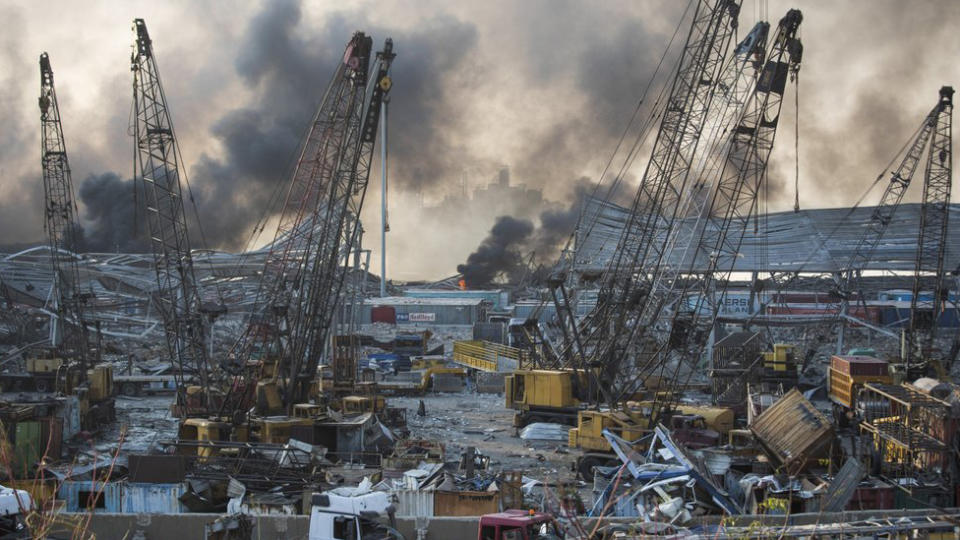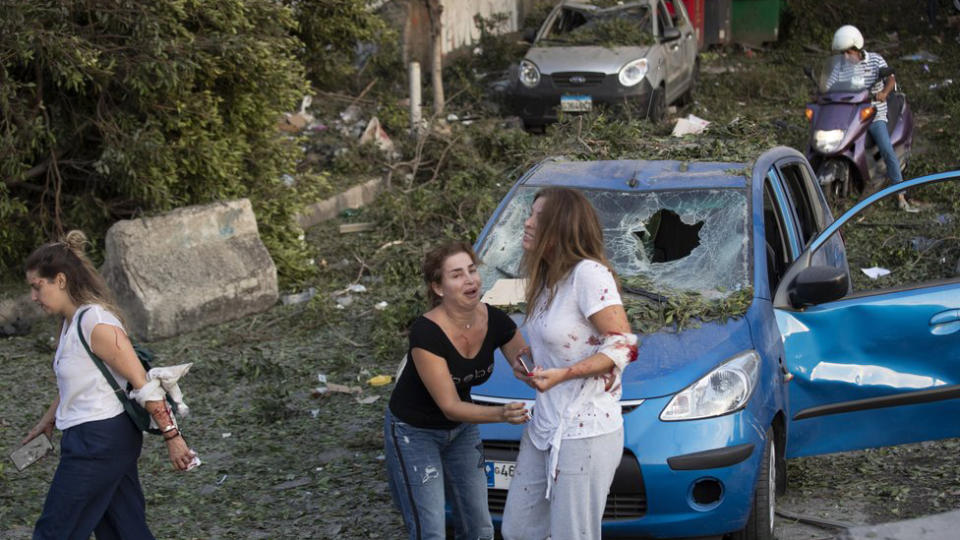Revealed: The deadly mix that caused devastating Beirut explosion
Lebanese rescue workers are digging through rubble looking for survivors after a massive warehouse explosion sent a devastating blast wave across Beirut, killing at least 100 people and injuring nearly 4000.
A deadly mix of fireworks and ammonium nitrate appear to have been the fuel that ignited the blast that rocked the country’s capital, experts and videos of the blast suggest.
The death toll is expected to rise.
The scale of the damage - from the epicentre of the explosion to the windows blown out kilometres away - resembles other blasts involving the chemical compound commonly used as an agricultural fertiliser.
Online videos of the disaster's initial moments show sparks and lights inside the smoke rising from the blaze, just prior to the massive blast.

That likely indicates that fireworks were involved, said Boaz Hayoun, owner of the Tamar Group, an Israeli firm that works closely with the Israeli government on safety and certification issues involving explosives.
"Before the big explosion, you can see in the centre of the fire, you can see sparks, you can hear sounds like popcorn and you can hear whistles," Hayoun told The Associated Press.
‘Looks like an accident’
Jeffrey Lewis, a missile expert at the Middlebury Institute of International Studies in Monterey, California, offered a similar assessment.
"It looks like an accident," Lewis told the AP. "First, there was a fire preceding the explosion, which is not an attack. And some of the videos show munitions what I could call popcorning, exploding like 'pop, pop, pop, pop."'
He added that "it's very common to see fires detonate explosives."

The white cloud that accompanied the massive blast appeared to be a condensation cloud, often common in massive explosions in humid conditions that can follow the shock waves of an explosion, Lewis said.
Orange clouds also followed the blast, likely from toxic nitrogen dioxide gas that's released after an explosion involving nitrates.
Experts should be able to determine the power of the blast by measuring the crater left behind, which appeared massive in aerial footage shot on Wednesday morning by AP.
The explosion was the most powerful ever to rip through Beirut, a city still scarred by civil war three decades ago and reeling from an economic meltdown and a surge in coronavirus infections.

‘Those responsible will pay’
President Michel Aoun said 2750 tonnes of ammonium nitrate, used in fertilisers and bombs, had been stored for six years at the port without safety measures. He called it "unacceptable".
An official source familiar with preliminary investigations blamed the incident on negligence. Ordinary Lebanese directed anger at politicians who have overseen decades of state corruption and bad governance that plunged the nation into financial crisis.
Prime Minister Hassan Diab promised accountability for the blast at the "dangerous warehouse", adding "those responsible will pay the price".
The head of Lebanon's Red Cross, George Kettani, said at least 100 people had been killed.

"We are still sweeping the area. There could still be victims. I hope not," he said.
The intensity of the blast threw victims into the sea and rescue teams were still trying to recover bodies. Many of those killed were port and custom employees and people working in the area or driving through during rush hour.
Facades of central Beirut buildings were ripped off, furniture was sucked into streets and roads were strewn with glass and debris. Cars near the port were flipped over.
"This is the killer blow for Beirut, we are a disaster zone. My building shuddered, I thought it was an earthquake," said Bilal, a man in his 60s, in the downtown area.

It remains unclear what conditions the ammonium nitrate had been stored in - or why tonnes of an explosive chemical compound had been left there for years.
It is also unclear what conditions a possible shipment of fireworks at the port had been stored in. Fireworks are very common in Lebanon, used to celebrate religious occasions and weddings.
While military explosives are generally safe to transport, common "cheap pyrotechnics" made in China are often of very low quality and can ignite very easily, especially in hot weather, said Hayoun, the Israeli explosives expert.
Explosion heard 160km away
Officials did not say what caused the blaze that set off the blast.
A security source and media said it was started by welding work being carried out on a hole in the warehouse.
The blast was heard as far away as Cyprus, a Mediterranean island about 160km away.
The port district was left a tangled wreck, disabling the nation's main route for imports needed to feed a nation of more than six million people.
Lebanon has already been struggling to house and feed hundreds of thousands of refugees from Syria.
The explosion came three days before a UN-backed court is due to deliver a verdict in the trial of four suspects from the Shi'ite Muslim group Hezbollah over a 2005 bombing that killed former Prime Minister Rafik al-Hariri and 21 others.
Hariri was killed by a huge truck bomb on the same waterfront.
Do you have a story tip? Email: newsroomau@yahoonews.com.
You can also follow us on Facebook, Instagram and Twitter and download the Yahoo News app from the App Store or Google Play.



